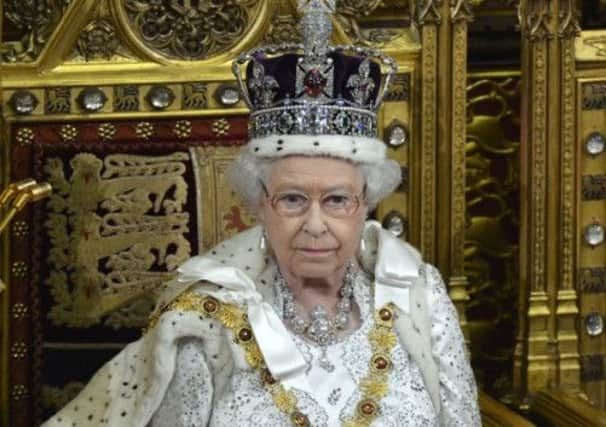Ice work if you can get it... by Royal command


That is what Scarborough snapper David Chalmers discovered when he was asked to capture the Royal Family’s most precious regalia on camera in 1993 before the jewels moved to a new home in the Tower of London.
Now, two decades later, he is to bring his extraordinary shots to life in an illustrated talk to mark the week of the 60th anniversary of the Queen’s coronation.
Advertisement
Hide AdAdvertisement
Hide AdMr Chalmers was only a year into his career as an advertising photographer in London when his agent landed him the once-in-a-lifetime commission.
“I had never even seen them and I had no interest in them particularly, but it just landed on my doorstep and I embraced it,” he said.
“Now I look back and on reflection it was quite an honour. I don’t think there will have been many people who have had a private view of the crown jewels.
“It was certainly one of the more interesting jobs of my career.”
Advertisement
Hide AdAdvertisement
Hide AdThe shoot was carried out deep in the concrete vault of the Tower’s Waterloo Barracks, in the old Jewel House where the regalia had been stored since 1967.
“They wouldn’t release it to my studio – I don’t know why,” Mr Chalmers joked.
Aside from the Royals themselves, the only person authorised to touch the collection’s precious treasures is the Queen’s Crown Jeweller, who by necessity became the photographer’s assistant on the shoot. The post was then held by David Thomas, of the world’s oldest jewellery house, Garrard, in Mayfair.
“I wasn’t allowed to touch anything to position it,” said Mr Chalmers.
Advertisement
Hide AdAdvertisement
Hide Ad“You’re talking about small items that need only a millimetre of movement but David couldn’t have been better.
“I’ve shot a lot of fragile items that need handling with cotton gloves, it’s all in a day’s work to me, but they didn’t want people dropping things that are priceless and irreplaceable.”
The commission came with a number of other unusual clauses.
“I had to sign the Official Secrets Act, so there are some things I can’t tell, and they also vetted me to see if there were any diamond thieves in the family,” he said.
“They were very, very cautious. That was a first for me in terms of unusual contracts.”
Advertisement
Hide AdAdvertisement
Hide AdThe shoot, which took place over 12 weeks, also had to be carried out at night, so the attraction would not have to be closed to visitors.
“It was a pain carrying equipment down four flights of stairs every night. We weren’t allowed to leave anything,” said Mr Chalmers.
“It was a strange feeling leaving the Tower at midnight. At night the guards are in combat gear and there we are, leaving with big bags of stuff on our backs.”
Mr Chalmers used his prized 1950 Deardorff camera to capture the dazzling array of crowns, sceptres, orbs and jewellery.
Advertisement
Hide AdAdvertisement
Hide Ad“Some of the stuff is quite vulgar but you have to remember it was made 400 to 500 years ago and you have to appreciate the craftsmanship and time that has gone into making it,” he said.
His favourite piece to photograph was the Royal Sceptre, which contains what is believed to be the world’s largest diamond – the Star of Africa.
“It’s a big rock – solid diamond – in the sceptre the Queen held at her coronation,” he said.
“It looks like a princess’s wand. I enjoyed shooting that because it was technically very pretty and we got some good results.”
Advertisement
Hide AdAdvertisement
Hide AdBut his favourite image was the one he took of the Imperial State Crown, which is worn by the Queen during the State Opening of Parliament each year.
“It’s a very abstract shot of a section of the crown,” he said.
“The crown was originally going to be at a bit of an angle but they didn’t like any tilt of the crown – I was told it signifies the falling of the monarchy.
“So we did it with the crown at the correct orientation. I did a shot of some of the pearls and velvet and diamond detail and that was my favourite image.”
Advertisement
Hide AdAdvertisement
Hide AdThe shot was used on the cover of the souvenir guide the pictures were commissioned for, which celebrated the moving of the regalia to a new, bigger Jewel House on the barracks’ first floor.
“I was proud of it. It was a nice creative challenge done very well as a team effort,” said Mr Chalmers.
“It was a nice feeling knowing the Queen has seen it and she got given a diamond-encrusted, leather-bound copy. She never rang me but she must have liked it because I’m still here.”
Mr Chalmers’ original photographs and the camera used to take them will be shown during his talk at Scarborough Art Gallery. Places for the event, at 12.30pm on Friday June 7, must be booked by calling 01723 374753 and standard entry fees apply.